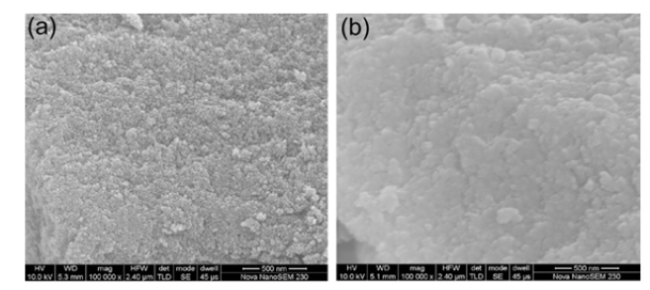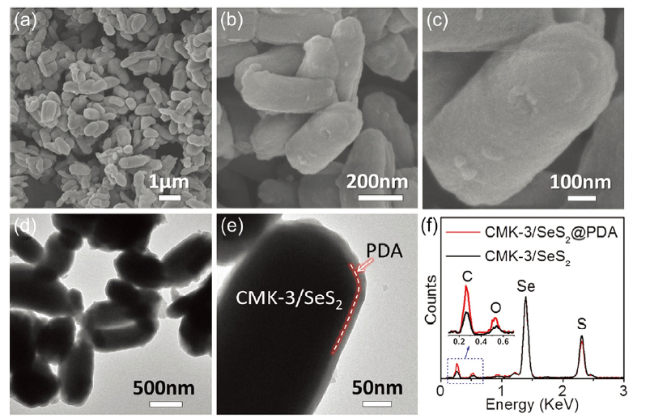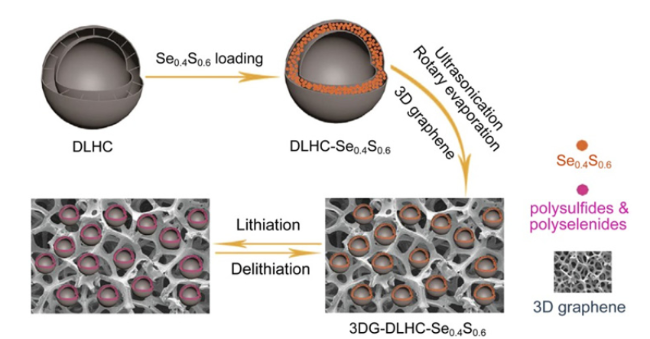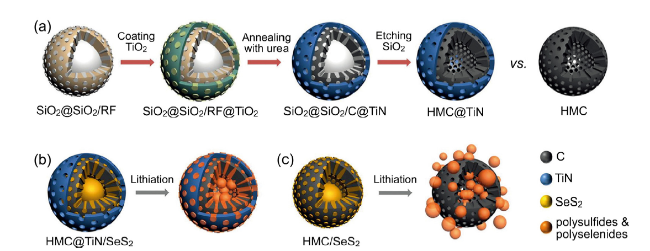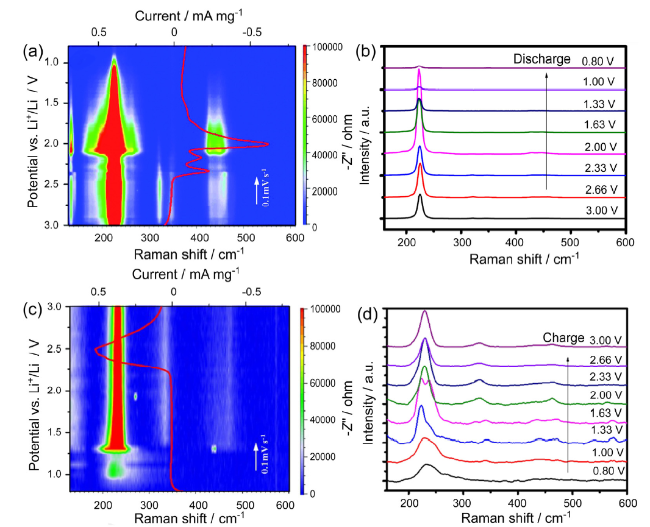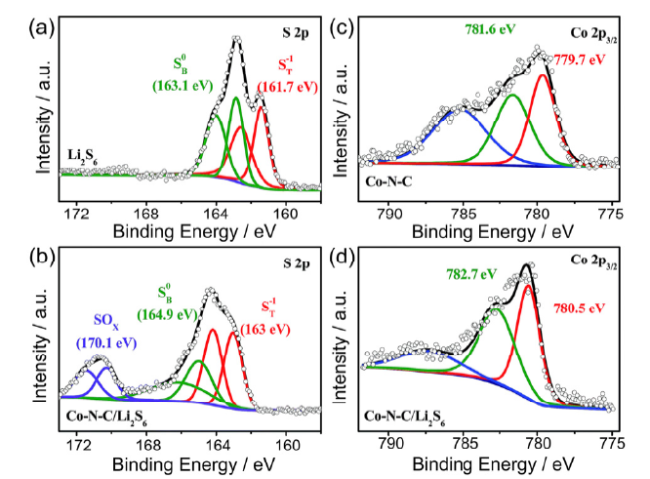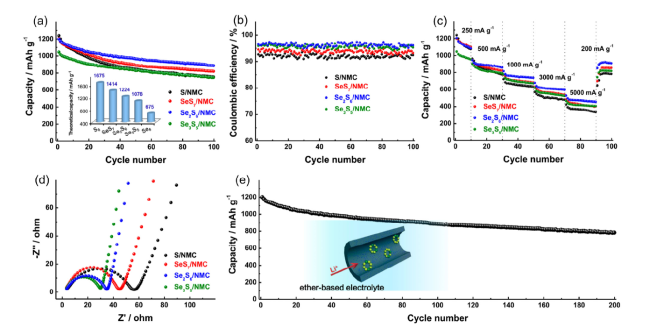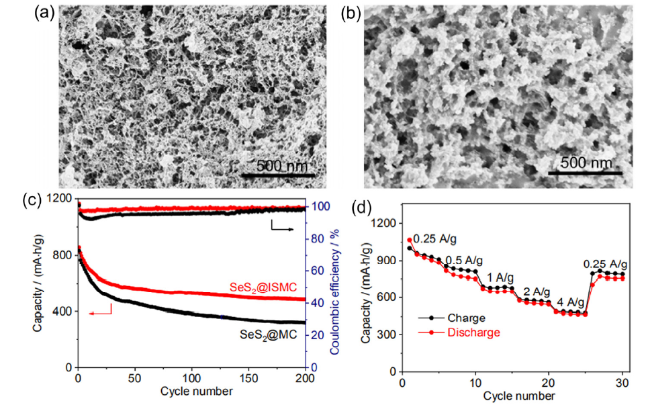0 引言
1 工作原理和面临的挑战
1.1 工作原理
1.2 面临的挑战
2 正极材料的研究
2.1 碳材料
2.2 金属化合物
Fig. 6 (a) Process for the synthesis of HMC@TiN; (b) with the TiN shell, dissoluble polysulfide/polyselenide could be effectively confined within the host during cycling; (c) in the bare HMC/SeS2 composite, the intermediates could readily diffuse out of the carbon host during cycling[49]图6 (a)HMC@TiN的合成方法;(b)利用TiN外壳可以有效地将可溶性多硫化物/多硒化物限制在载体内;(c)在裸露的HMC/SeS2复合材料中,中间产物在循环过程中很容易从碳载体中扩散出去[49] |
2.3 金属-有机框架
Fig. 8 (a) C-V curve and contour plot of Raman spectra of the Co-N-C/SeS2 electrode recorded in the initial cathodic scan; (b) selected original Raman spectra, corresponding to (a); (c) CV curves and contour plot of Raman spectra of the Co-N-C/SeS2 electrode recorded in the initial anodic scan; (d) selected original Raman spectra, as corresponding to (c)[24]图8 (a)首次正极扫描记录的Co-N-C/SeS2电极拉曼光谱的CV曲线和轮廓图;(b)选定的拉曼光谱,与(a)对应;(c)初始负极扫描记录的Co-N-C/SeS2电极拉曼光谱的CV曲线和轮廓图;(d)选定的原始拉曼光谱,与(c)对应[24] |
Fig. 10 Cycling performance (a) and coulombic efficiency (b) of SenS8-n/NMC (n = 1-3) at 250 mA/g; (c) rate performances of SenS8-n/NMC (n = 1-3) at different current densities; (d) EIS of SenS8-n/NMC (n = 1-3) before the first cycle; (e) long-term cycling performance of Se2S6/NMC at 250 mA/g[16]图10 SenS8-n/NMC(n = 1 ~ 3)在250 mA/g时的循环性能(a)和库仑效率(b);(c)不同电流密度下SenS8-n/NMC(n = 1 ~ 3)的速率性能;(d)第一次循环前SenS8-n/NMC (n = 1 ~ 3)的EIS;(e)SenS8-n/NMC在250 mA/g时的长循环性能[16] |
2.4 杂原子掺杂材料
3 结论与展望
Table 1 Different hosts load SexSy composite cathodes表1 不同载体负载SexSy复合正极 |
| Meterial | Initial capacity / (mA∙h/g) | C-rate | Cycle number | Cycling stability / % | Ref. |
|---|---|---|---|---|---|
| SeS2@ISMC | 858.0 | 0.5 A/g | 200 | 56.6 | [18] |
| S0.94Se0.06/C | 1 755 | 0.2 A/g | 200 | 61.4 | [19] |
| Co-N-C/SeS2 | 1 153.5 | 0.2 C | 200 | 84.1 | [24] |
| Se2S5/MCM | 1 150.6 | 1 C | 100 | 60.6 | [26] |
| SeS2@MCA | 846.0 | 0.5 A/g | 10 | 71.0 | [29] |
| CMK-3/SeS2@PDA | 1 234.0 | 0.2 A/g | 150 | 63.5 | [38] |
| SeS2/HMCNCs | 986.3 | 0.2 A/g | 100 | 82.3 | [41 |
| 3DG-DLHC-Se0.4S0.6 | 667.0 | 1 A/g | 500 | 54.9 | [44] |
| MYS-Co4N@C/SeS2 | 909.0 | 0.5 C | 300 | 73.6 | [47] |
| HMC@TiN/SeS2 | 987.0 | 0.2 C | 50 | 85.1 | [48] |
| CoS2@LRC/SeS2 | 1 015.0 | 0.2 A/g | 100 | 73.4 | [52] |





